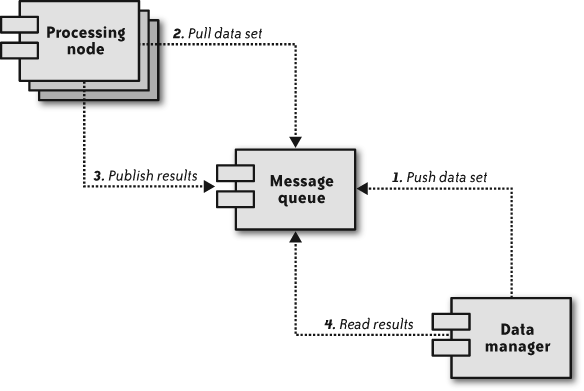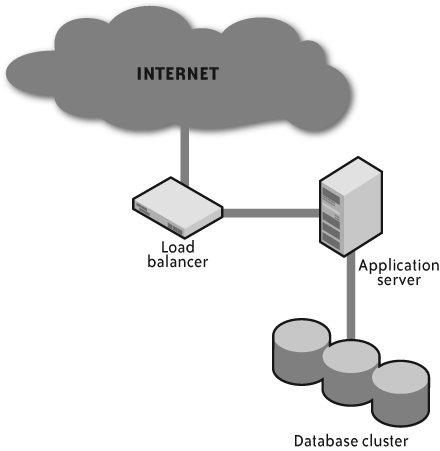Cloud Application Architectures
We could spend a lot of precious paper discussing Software as a Service or virtualization technologies (did you know that you can mix and match at least five kinds of virtualization?), but the focus of this book is how you write an application so that it can best take advantage of the cloud.
Grid Computing
Grid computing is the easiest application architecture to migrate into the cloud. A grid computing application is processor-intensive software that breaks up its processing into small chunks that can then be processed in isolation.
If you have used SETI@home, you have participated in grid computing. SETI (the Search for Extra-Terrestrial Intelligence) has radio telescopes that are constantly listening to activity in space. They collect volumes of data that subsequently need to be processed to search for a nonnatural signal that might represent attempts at communication by another civilization. It would take so long for one computer to process all of that data that we might as well wait until we can travel to the stars. But many computers using only their spare CPU cycles can tackle the problem extraordinarily quickly.
These computers running SETI@home—perhaps including your desktop—form the grid. When they have extra cycles, they query the SETI servers for data sets. They process the data sets and submit the results back to SETI. Your results are double-checked against processing by other participants, and interesting results are further checked.[3]
Back in 1999, SETI elected to use the spare cycles of regular consumers’ desktop computers for its data processing. Commercial and government systems used to network a number of supercomputers together to perform the same calculations. More recently, server farms were created for grid computing tasks such as video rendering. Both supercomputers and server farms are very expensive, capital-intensive approaches to the problem of grid computing.
The cloud makes it cheap and easy to build a grid computing application. When you have data that needs to be processed, you simply bring up a server to process that data. Afterward, that server can either shut down or pull another data set to process.
Figure 1-1 illustrates the process flow of a grid computing application. First, a server or server cluster receives data that requires processing. It then submits that job to a message queue (1). Other servers—often called workers (or, in the case of SETI@home, other desktops)—watch the message queue (2) and wait for new data sets to appear. When a data set appears, the first computer to see it processes it and then sends the results back into the message queue (3). The two components can operate independently of each other, and one can even be running when no computer is running the other.
Cloud computing comes to the rescue here because you do not need to own any servers when you have no data to process. You can then scale the number of servers to support the number of data sets that are coming into your application. In other words, instead of having idle computers process data as it comes in, you have servers turn themselves on as the rate of incoming data increases, and turn themselves off as the data rate decreases.
Because grid computing is currently limited to a small market (scientific, financial, and other large-scale data crunchers), this book doesn’t focus on its particular needs. However, many of the principles in this book are still applicable.
Transactional Computing
Transactional computing makes up the bulk of business software and is the focus of this book. A transaction system is one in which one or more pieces of incoming data are processed together as a single transaction and establish relationships with other data already in the system. The core of a transactional system is generally a relational database that manages the relations among all of the data that make up the system.
Figure 1-2 shows the logical layout of a high-availability transactional system. Under this kind of architecture, an application server typically models the data stored in the database and presents it through a web-based user interface that enables a person to interact with the data. Most of the websites and web applications that you use every day are some form of transactional system. For high availability, all of these components may form a cluster, and the presentation/business logic tier can hide behind a load balancer.
Deploying a transactional system in the cloud is a little more complex and less obvious than deploying a grid system. Whereas nodes in a grid system are designed to be short-lived, nodes in a transactional system must be long-lived.
A key challenge for any system requiring long-lived nodes in a cloud infrastructure is the basic fact that the mean time between failures (MTBF) of a virtual server is necessarily less than that for the underlying hardware. An admittedly gross oversimplification of the problem shows that if you have two physical servers with a three-year MTBF, you will be less likely to experience an outage across the entire system than you would be with a single physical server running two virtual nodes. The number of physical nodes basically governs the MTBF, and since there are fewer physical nodes, there is a higher MTBF for any given node in your cloud-based transactional system.
The cloud, however, provides a number of avenues that not only help mitigate the lower failure rate of individual nodes, but also potentially increase the overall MTBF for your transactional system. In this book, we cover the tricks that will enable you to achieve levels of availability that otherwise might not be possible under your budget while still maintaining transactional integrity of your cloud applications.
[3] For more information on SETI@home and the SETI project, pick up a copy of O’Reilly’s Beyond Contact (http://oreilly.com/catalog/9780596000370).
Get Cloud Application Architectures now with the O’Reilly learning platform.
O’Reilly members experience books, live events, courses curated by job role, and more from O’Reilly and nearly 200 top publishers.



